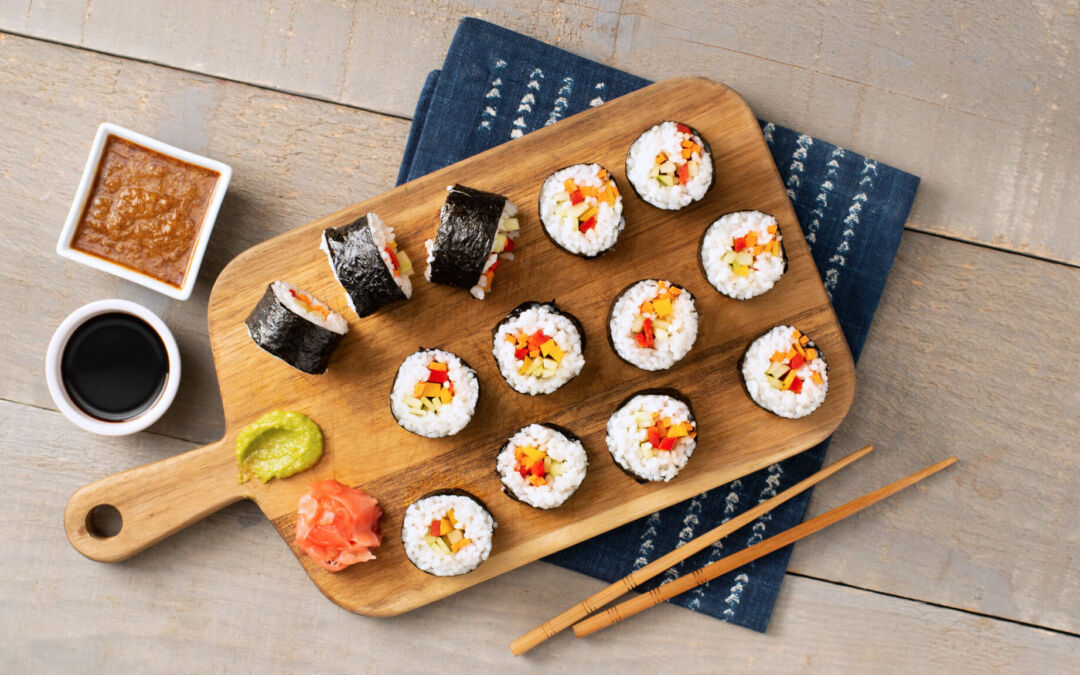Mastering the art of sushi is a task that can take a lifetime. But don’t let that stop you from beginning your journey! Start practicing now and — before you know it — you’ll be plating amazing appetizers and preparing mouthwatering meals.
Sushi seems simple, however, it is full of nuances and depth. It has incredible flavor but it isn’t as difficult as you may think to make at home! It’s easy to get intimidated by the unfamiliar vocabulary, foreign kitchen tools, and overly simplistic recipe instructions. But fear not, think of this handy Sushi 101 guide as a prologue to your sushi journey! Learn the ins and outs of this Japanese classic and by the time you get through this basic guide, you’ll have all the knowledge you need to become a real itamae, or Japanese sushi chef. Let’s start with the basics and move on from there.
What is Sushi?
First things first, what exactly is sushi? There’s a misconception that sushi is raw fish or just maki (typical sushi rolls); however, sushi simply refers to mixing short grain sushi rice with vinegar, and sometimes sugar and salt, for a tasty, bite-sized creation.

Where Did Sushi Come From?
To understand why, let’s take a look at the origins of sushi itself. In the past, the Japanese would preserve fish by wrapping it in fermented rice. Eventually, vinegar was added to prolong its freshness, and the rice would then be thrown away while the fish was eaten. When they realized that the combination of flavors was incredible, they began eating the fish wrapped in vinegared rice. Today, common sushi dishes may or may not include fish, but rice is indispensable.
What’s the Difference Between Sushi, Onigiri and Sashimi?
In short, sushi is all about the combination of compact grains and balanced seasoning that creates an irresistible, distinct flavor and an essential texture for Japanese cuisine. Though some Japanese dishes are similar, they aren’t technically considered sushi — not that they aren’t just as delicious!
- Sashimi refers to high-quality, thinly sliced meat; this flavorful delicacy — typically high-grade fish — is served without rice, often with sauces.
- Onigiri, although it may look like sushi, is not technically a variety. This is because it is not made with sushi rice, but rather white rice. However, there are certain fusion recipes like Yaki Onigiri that season the white rice for a tasty yet slightly sticky recipe. Or for a flavor explosion, these Spanish Inspired Shrimp Onigiri are a real treat. We use sushi grains for these onigiri, making it a bit easier for beginners to form the seafood packed, cylinder or triangle-shaped balls.
How to Make Homemade Sushi Rolls
Now, it’s time to roll up your sleeves and start making your own sushi rolls at home.
How to Make Sushi Rice
The key to unforgettable sushi is choosing the right rice. Not all varieties are suitable for making sushi. Whereas jasmine rice recipes call for a long grain that isn’t very sticky, sushi calls for a short grain rice with a higher starch content. Mahatma® Sticky Rice is ideal as it is a firm grain that not only clings together nicely, but also absorbs a ton of flavor.
Keep your pantry stocked with plenty of this versatile variety so you can practice whenever the craving strikes. Get the perfect rice for any sushi recipe by following these tips:
- Rinse Repeatedly: Rinse any excess starch from the grains in a bowl with cold water — about five or six times — until the water runs clear. Skipping this step will result in a thick paste that will be impossible to season.
- Get Cooking: Find a pot in which steam can’t escape. For best results, use a rice cooker (suihanki), instant pot, or slow cooker.
- Stir Things Up: Stir the rice immediately after it finishes cooking so it cools while also releasing humidity.
- Dress it Up: Season the rice with a blend of rice wine vinegar, sugar and salt. This mixture adds flavor and helps keep your masterpiece together.
- Cool Down: Lastly, let the rice sit and cool down before handling it: you can use an uchiwa or traditional paper and bamboo fan.
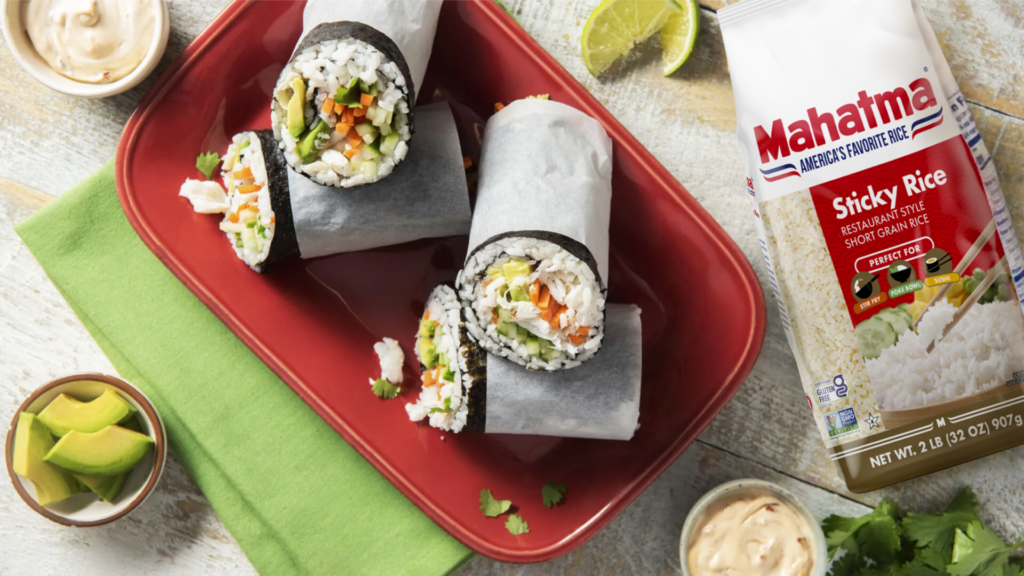
It’s not a problem if you don’t have all of the traditional cooking tools. As long as you carefully handle the ingredients and follow the instructions, you’ll have delicious sushi!
How To Roll Maki
When people think of sushi, they typically imagine maki rolls. It takes practice, but even those trial rolls are delicious! When you are ready to take on the challenge of rolling, there are a few important things to note:
While the rice is cooking, prep your sushi station:
- Place a rolling mat— covered in plastic wrap — in front of you, with the wooden slats running horizontally.
- Lay a piece of nori on top — shiny side down. You may want to carefully rip the sheets in half as it’ll be easier to roll a smaller amount.
Once the rice has cooled down, it’s time to roll.
- Spread approximately 1 cup of fresh sushi rice evenly atop the dried seaweed, leaving a half inch border.
- Lay your ingredients in the center.
- Take your rolling mat and fold it over your filling. Then, use the mat to “tuck-in” your ingredients. Once it feels compact and secure, continue rolling.
- Release the mat and — before you marvel at your handiwork — run your finger along the seam with a drop of water to seal the deal.
- We’re almost done! Use the mat to give it a quick roll for peace of mind to ensure everything stays in place.
- Cut maki roll with a wet, sharpened knife. Keep a dishcloth handy so you can wipe the knife after each cut. You may consider investing in a good set of hocho or Japanese knives, because they really are the “soul” of any accomplished itamae.
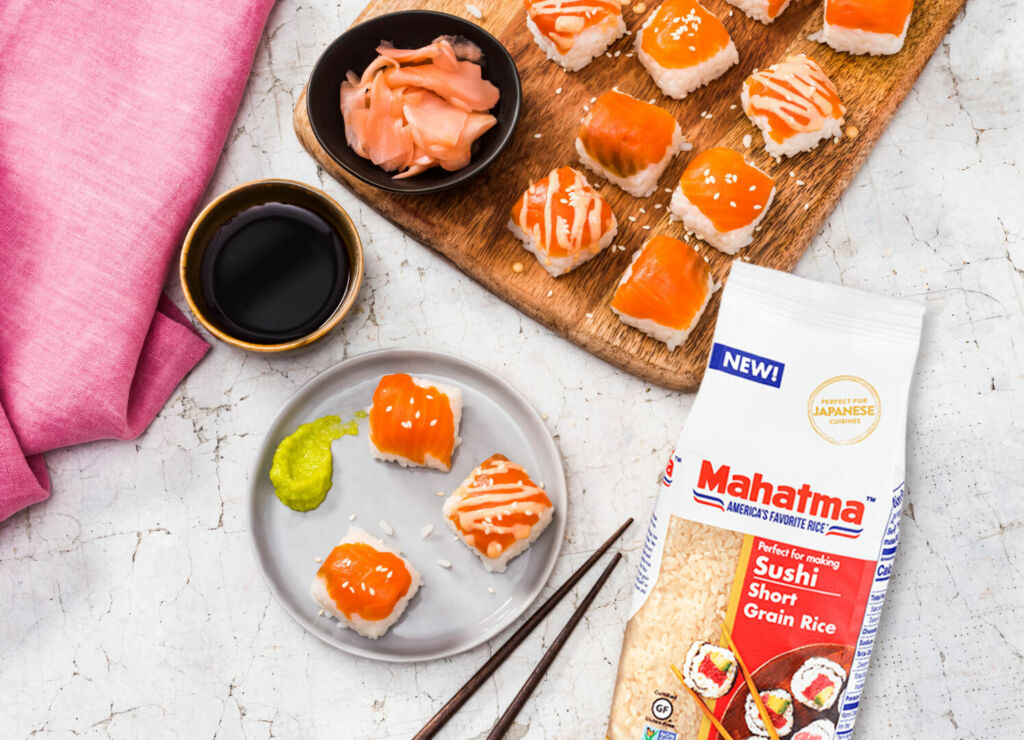
Maki Sushi Recipes
For those who may not be brave enough to take on raw fish, our Vegetarian Sushi Rolls are a good place to start: simply wrap your choice of ingredients like carrots, peppers, and cucumber or guacamole and rice in nori seaweed. Or, try out a Sticky Rice: it’s perfect for making authentic sushi dishes. Maki with fewer ingredients — in this case tuna and avocado — is easier to control when rolling.
If this seems a bit intimidating, our Pressed Sushi with Salmon is an ideal beginner sushi recipe. It boasts all the flavor of your favorite maki without any of the rolling! This is the perfect opportunity to practice making sushi rice without the pressure of presentation — using an ice cube tray is foolproof! Plate with a good soy sauce, wasabi, and ginger and you’re all set.
More Types of Sushi
If you’ve ever gone to a sushi restaurant, you’ll know there are plenty of other sushi varieties aside from tasty maki rolls. Try your hand at some of these others:
- Nigiri: Topped with quality fish, nigiri is a simple, hand-formed mound of sticky rice: it’s simple, yet delicious! For the most decadent morsel, the sushi-grade fish is a must – it’s packed with flavor and safe to eat.
- Chirashi: For a satisfying bowl, pile sashimi and vegetables atop a bed of sticky rice for this delicious bowl.
- Temaki: This to-go sushi is a popular street food! Spread some sticky rice on a sheet of nori and then top with fresh fish, crisp veggies, or crunchy tempura. After adding all your favorite mix-ins, roll it up into a tight cone; all that’s missing is a drizzle of your favorite sauce!
There are plenty more sushi dishes to add to the list — but these varieties will help you start your sushi journey!
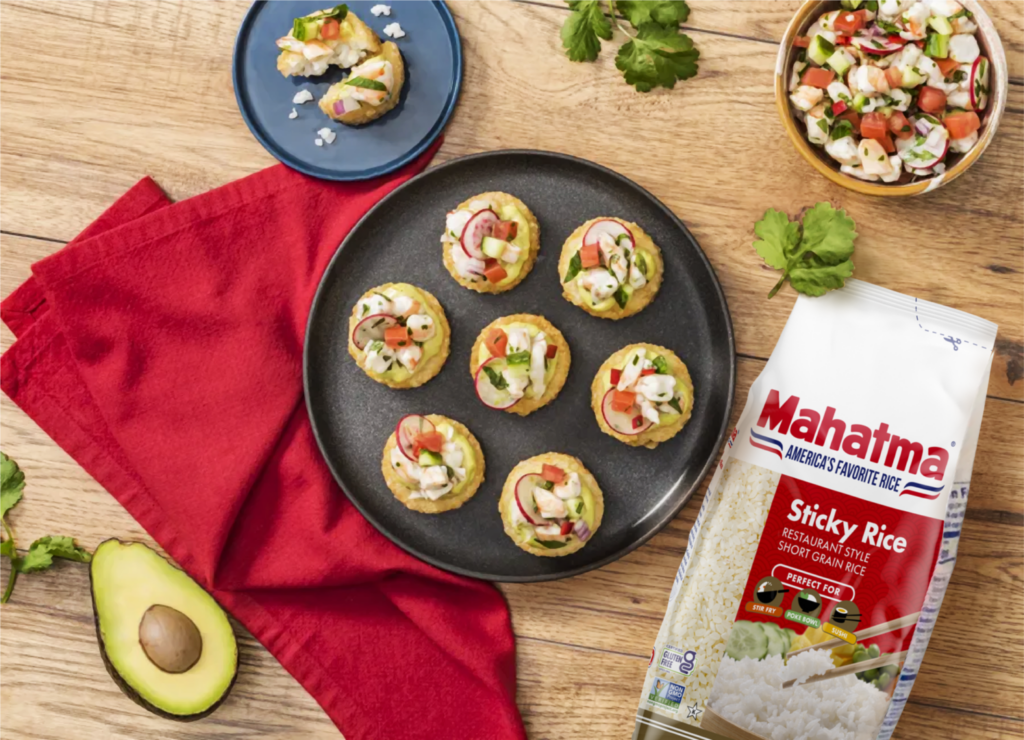
Other Recipes Using Short Grain Sushi Rice
Time to get creative! From appetizers to desserts, short grain rice is the ideal grain for more than making traditional Japanese sushi. Don’t be afraid to unfollow the recipe and adapt each of these creations to your liking. Here are some tasty meals with sushi rice that you won’t find on any menu but yours.
Appetizers
Canapés: Now that you’re a regular at the fish market, you can try your hand at our Shrimp Ceviche with Crispy Rice recipe. Make sure you make enough of these crispy, bite-sized appetizers, because you and your guests will not be able to resist them!
Sushi Stacks: Reach new heights with these Sushi Stacks. Ditch the nori sheets and simply pile up the sushi rice for this show-stopping sweet and savory tower presentation. These stacks are larger than classic sushi rolls and give your table an exquisite touch.
Main Dish
Poke Bowl: Reminiscent of Japanese chirashi, these Hawaiian poké bowls are tasty and delicious served over a bed of sushi rice: Orange Miso Sesame Tuna or Orange Miso Sesame Salmon Poke Bowl.
Burritos: For a meal on the go, try our filling Fusion Sushi Crab Burrito — it’s a unique take on the Japanese classic.
Bento Box: While this Japanese-inspired Bento Box is made using traditional Mahatma® White Rice, sushi rice can easily be swapped in!
California Sushi Bowl: For a filling sushi fusion experience, try our mouthwatering California Sushi Bowl.
Desserts
Maki isn’t just for savory creations; in fact, our sweet Fruit Sushi is a fun way to introduce kids to the world of Japanese cuisine! Or for another recipe in the sweets department, try these luscious Rice Truffles made with matcha green tea coated in melted white chocolate. For a classic Latin American dessert try this Arroz con Leche recipe.
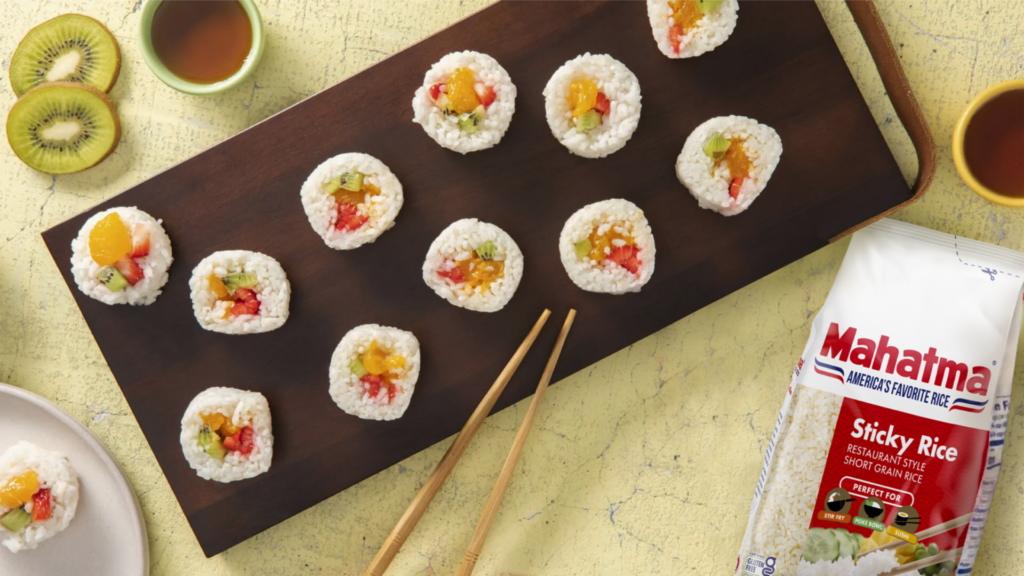
Whether you’re just starting out, getting back to basics, or adding new recipes to your repertoire like these tacos with rice and beans, keep this guide close at hand. Wow yourself and your guests with your new knowledge of sushi and other delicious new dishes. Take that first step toward mastering the art of sushi at home and then move on to other incredible meals like a Mexican Chicken and Rice Casserole or an arroz con leche! For more recipes and to have your questions answered like what is jasmine rice? Check out our website.
